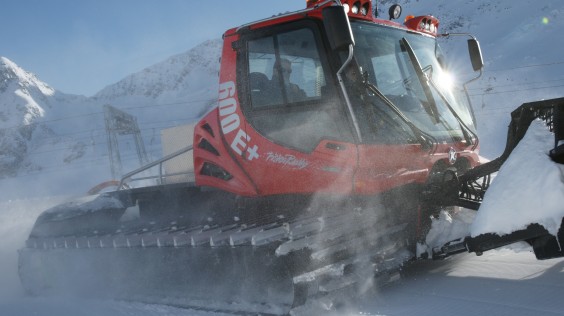New Engines Technology
When developing new technologies, Kässbohrer Geländefahrzeug AG always remains conscious of the environmental impact. That´s why the vehicles being introduced are all equipped with engines that meet the strict EURO 3B/TIER 4i exhaust emission standards. These 3B engines are capable of greater performance:
That´s why the vehicles being introduced are all equipped with engines that meet the strict EURO 3B/TIER 4i exhaust emission standards. These 3B engines are capable of greater performance:
- PB100 – 204hp
- PB 600 – 455hp
- PB600 Polar – 510hp
All the vehicles are also available with engines that meet these standards but numbers are limited. “GreenIQ” is Kässbohrer Geländefahrzeug AG’s concept for PistenBully with economical engines and exhaust technology.
First diesel-electric vehicle worldwide grooming the Alpine slopes!
The PistenBully 600E+ with diesel-electric drive consumes up to 20% less fuel and emits less CO2. Attachments powered hydraulically to date can now be powered electrically.
This concept enables us to turn the PistenBully into a kind of powerstation in future.
Description of Diesel-electric drive:
Environmentally-friendly, economical and cost-effective.
Strictly speaking, diesel-electric drives are electric drives, which carry their own power plant – a generator, which is driven by a powerful diesel engine. The electrical energy produced supplies electric motors in addition to the propulsion motors for the direct actuation of the tiller and winch. With this technology the PistenBully 600 E+ becomes a sort of power station, which also allows you to connect external devices. The advantages are obvious: in comparison to a hydrostatic drive, the same or even a higher level of efficiency is achieved with lower power. The lower fuel consumption by up to 20 % is a particular advantage. On the one hand, this reduces emissions; on the other, the operating costs are lower and the vehicle becomes more cost-effective. Moreover, the energy is regained on the downhill rides and is used to drive the snow tiller.

This type of drive also has advantages from a purely functional perspective, because you don’t need a hydraulic drive for attachments, but can operate them electrically. This also does away with the need for hydraulic pumps and hoses and the associated risk of leakages. The hybrid drive also provides enough power to operate external electric tools, e.g. for repair work. The diesel-electric drive was developed in close cooperation with external partners and universities.




